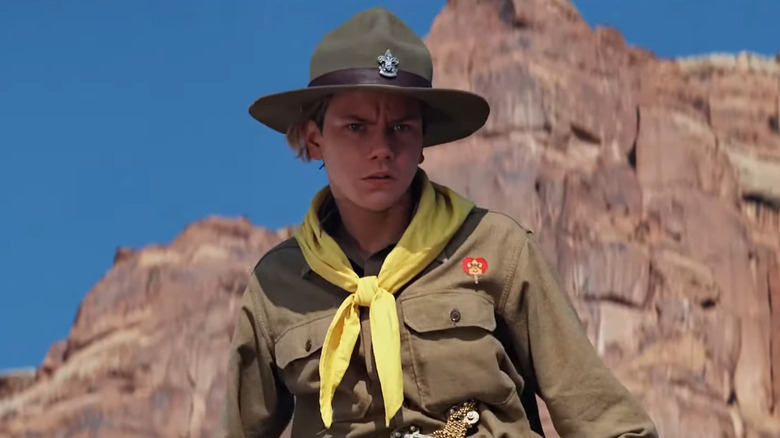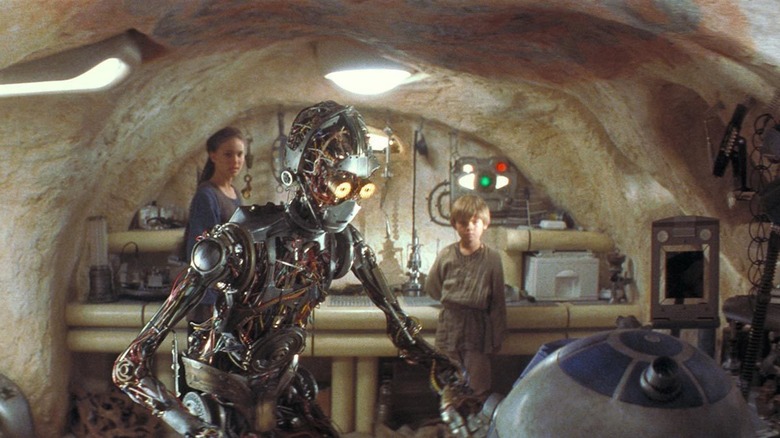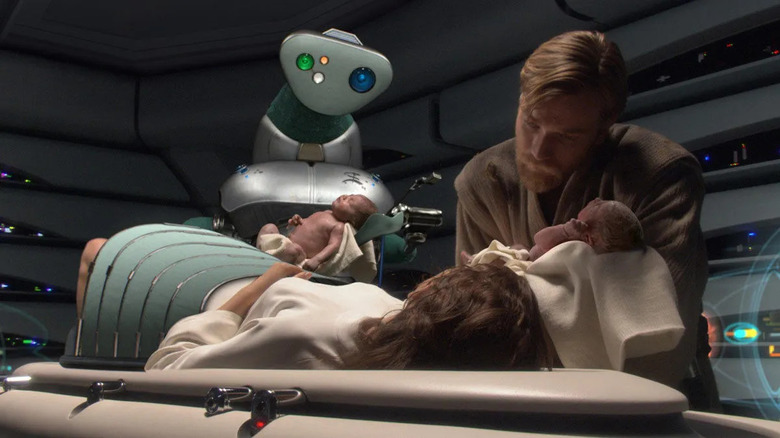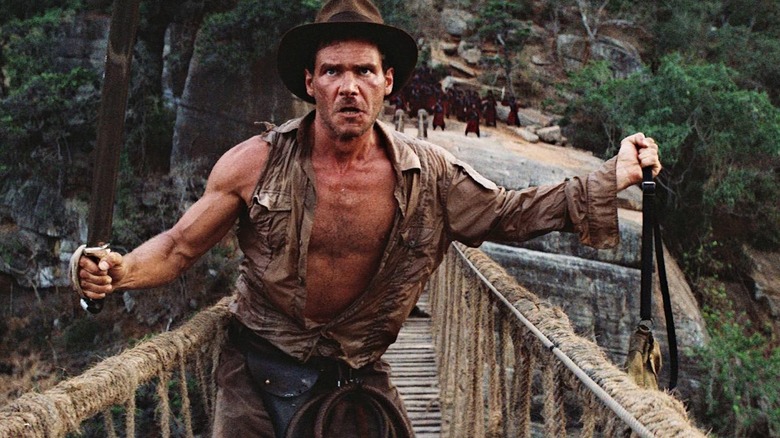Indiana Jones And The Last Crusade Kickstarted George Lucas' Worst Habit
The opening sequence of "Indiana Jones and The Last Crusade" is essentially a mini-prequel film, bringing us back to teen Indy (played by River Phoenix) as he stumbles across some robbers stealing the Cross of Coronado. "That cross is an important artifact, it belongs in a museum," young Indy says. He gets caught stealing the cross from the robbers, who chase after him in a six-minute sequence that involves horses, trains, lions, snakes, and a magic trick that appears to involve actual magic. It's a classic Indiana Jones adventure, the CliffsNotes edition.
It's all a lot of fun, but it gets a little too cute with explaining away every little thing we know about Indiana Jones. How did Jones develop his fear of snakes? It's because he fell into a snake pit. How did he decide on a whip for his signature weapon? Because he got trapped in a room with a lion and grabbed a whip to protect himself. How did he get his signature hat? Because the main robber gave it to him as a begrudging sign of respect.
The way "The Last Crusade" frames it, you'd get the impression that Indy became Indy as a teenager in 1912 over the span of about 10 minutes and then stayed exactly the same for 26 years when the present-day plot of the film begins. It's not exactly a flaw in the film — the opening sequence is short, tongue-in-cheek, and very fun to watch — but watching it in 2023, the whole thing feels very familiar. In a world where franchises are constantly giving us prequels with concrete answers for every mysterious detail about its main characters, this 1989 film's approach has lost a bit of its charm.
Prequels done wrong
George Lucas had a big hand in the making of "The Last Crusade," and it's easy to see how the positive response to the movie could've given him the wrong idea. The film is often argued (correctly, of course) to be the best installment in the series due to how it delves into Indiana's past, deepening his character far more than the first two installments ever did. But while the relationship between Indy and his father Henry (Sean Connery) informs us of Indy's childhood in fresh, intriguing ways, that's not the part of the movie that Lucas brought into the "Star Wars" prequels.
Instead, Lucas seemed more inspired by the snakes/hat/whip stuff in the opening sequence. It's why "The Phantom Menace" barely sheds any light on Anakin's eventual path to the dark side, but it did take the time to reveal that it was young Anakin who invented C3PO, even though that makes no sense. It's why it clarified that R2-D2 became a part of the gang around this time, even though that also makes no sense.
At every chance these prequels got, they threw in a forced connection to the original trilogy. At first glance, it seemed like this would help the whole franchise feel more connected, but all it actually did was make the "Star Wars" universe feel depressingly small. This is a galaxy filled with thousands of planets, we've been told, so why does this whole universe seem to revolve around this one family?
The sense that nothing's changed
The worst thing the prequels did in this regard was create the sense that nothing important at all happened between the two trilogies. "Revenge of the Sith" ends with Obi-Wan and Yoda choosing to self-exile, already planning to embrace the hermit lifestyles we found them in during their original trilogy introductions. At first glance, this makes for a nice full-circle moment, but on second glance, it makes both characters look like cowards who pretty much gave up on fighting the Empire just a day or two into its reign.
The movie also feels the need to kill off Padme to explain how Luke and Leia became orphans, when it could've easily left that plot thread open and let audiences speculate on what happened to her in the kids' early years. (At the very least, this would've been better than her dying because she's sad.) But rather than create the sense that stuff still happened in the 20 years between trilogies, George Lucas chose to have the trilogy end in the same status quo "A New Hope" introduced us to. Like with that "Last Crusade" opening, but to a much larger degree, this created the sense that all the characters just kind of stop existing whenever the camera's not on them.
A prequel done right
It's ironic that "Star Wars" took so many cues from "The Last Crusade," considering that the movie's predecessor, "Temple of Doom," doesn't fall into any of those same traps. The film takes place a year before the events of "Raiders of the Lost Ark," but it makes few attempts to explain anything about how Indiana Jones ended up the way he is in the first movie. Here, Indiana inexplicably has a heartwarming father/son relationship with the young Short Round, and develops a relationship with Kate Capshaw's Willie Scott, a woman who's never mentioned in "Raiders" despite her and Indy ending "Temple of Doom" on good terms.
What ever happened to Short Round and Willie Scott? We never find out, and we don't need to find out. The movie is comfortable letting its audience fill in the blanks. It trusts us to understand that life for these characters keeps moving even after the credits roll, that they aren't living life on autopilot between films. The lack of answers makes the world of the "Indiana Jones" series feel so much larger than it otherwise would.
Of course, "Temple of Doom" was easily the most controversial of the original three "Indiana Jones" films, mainly due to how dark and mean-spirted it is, so it makes sense that this would be the film George Lucas would be the least likely to take any lessons from. It's a shame though, because when it comes to avoiding those soulless, predictable prequel clichés that have grown so common in modern blockbusters, "Temple" did it best of all.



